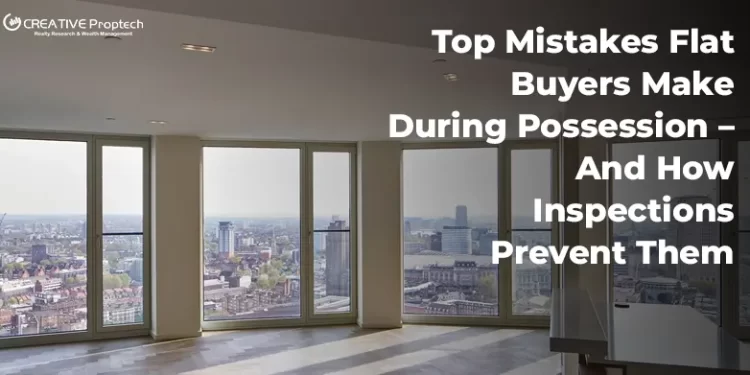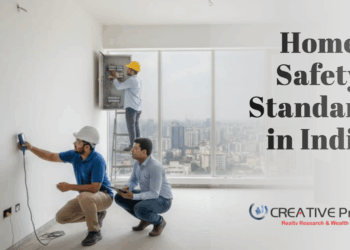Taking possession of a new flat is one of the most exciting moments for any homebuyer. After months of waiting, payments, and paperwork, finally receiving the keys feels like a dream fulfilled. But here’s the reality—possession is also the most critical stage in the buying journey. Many buyers, carried away by excitement, rush through this phase and miss crucial checks that can affect their investment for years.
From hidden dampness behind walls to uneven flooring or faulty wiring, construction defects often remain unnoticed during the final walkthrough. Once the property is registered and payments are complete, fixing these issues becomes a costly burden for the buyer. This is where a professional home inspection at possession becomes a game-changer.
In this blog, we’ll cover the top mistakes flat buyers make during possession and how a detailed home inspection can help avoid them, ensuring you move into a safe, durable, and truly livable home.

Skipping a Detailed Quality Check
Many buyers believe that since the flat is brand new, it must be flawless. Builders also highlight cosmetic finishes—fresh paint, polished tiles, shining doors—to create an impression of perfection. But construction defects often lie hidden behind the surface.
Example: A buyer in Mumbai moves into a flat with gleaming interiors but later discovers water seepage in bathroom walls due to improper waterproofing.
How Inspections Help:
- Inspectors use moisture meters to detect dampness invisible to the eye.
- Spirit levels and laser tools identify uneven flooring and wall alignment.
- Plumbing and electrical systems are tested under load to ensure functionality.
This ensures buyers catch flaws before making the final payment.
Relying Only on Builder’s Assurance
Most buyers assume the builder’s word or completion certificate is enough proof of quality. While these documents show that construction is officially complete, they don’t reflect the real condition of the flat.
Example: A Pune buyer trusted the builder’s assurance, only to find multiple cracked tiles and faulty bathroom fittings after moving in.
How Inspections Help:
- Independent inspectors act as a neutral third party.
- They provide a detailed snag list (defects report) that you can present to the builder.
- This list strengthens your negotiation power to demand repairs before handover.
Ignoring Structural and Safety Checks
During possession, most buyers focus on aesthetics—paint, fittings, doors—while overlooking structural elements like slab cracks, railing strength, or proper ventilation. Safety hazards often go unnoticed in the excitement.
Example: In a Navi Mumbai project, loose balcony railings were ignored during possession. This posed a major safety risk, which only came to light after a professional inspection.
How Inspections Help:
- Inspectors check beam, column, and slab integrity.
- Railings, staircases, and window frames are tested for strength.
- Ventilation and fire safety provisions are verified.
Such checks ensure your home is not just beautiful but safe for your family.
Overlooking Plumbing and Drainage Systems
Most buyers turn on taps for a quick check and assume plumbing is fine. But problems like low water pressure, leaking joints, or poor drainage flow may not be obvious in a short visit.
Example: A Thane homebuyer moved in only to face daily waterlogging in bathrooms due to poor slope and faulty drainage.
How Inspections Help:
- Inspectors check pipe leakages, faucet alignment, and water pressure.
- Drainage slopes are tested to avoid future waterlogging.
- Flush, geyser, and concealed plumbing are verified for efficiency.
Catching these defects early saves buyers from costly rework after possession.
Missing Electrical System Verification
Faulty wiring, loose switchboards, or poor earthing can lead to power failures or even fire hazards. Buyers often assume new flats won’t have such issues—but rushed construction often compromises electrical safety.
Example: In a newly delivered Powai tower, residents faced frequent tripping due to poor MCB panel installation.
How Inspections Help:
- Electrical sockets are tested with socket testers.
- Load balance and earthing are checked.
- Inspectors verify MCB panels, wiring gauge, and polarity.
This ensures electrical safety before you move in.
Not Checking for Hidden Dampness and Leakage
Dampness is one of the most common issues in Indian apartments, especially in high-rainfall cities like Mumbai. Buyers often miss it during possession because early seepage signs are concealed with fresh paint.
Example: A Bandra buyer noticed wall bubbles and peeling paint within two months of possession due to inadequate waterproofing.
How Inspections Help:
- Moisture meters detect hidden seepage.
- Thermal imaging identifies dampness inside walls.
- Waterproofing quality in bathrooms, kitchens, and balconies is checked.
This prevents future disputes with builders and heavy repair bills.
Rushing Possession Without Professional Guidance
Many buyers rush through possession day in excitement, completing formalities quickly without expert support. This results in missing serious defects that could have been identified with professional help.
Example: A first-time homebuyer in Pune accepted possession immediately, only to later discover that windows weren’t sealed properly, causing rainwater ingress.
How Inspections Help:
- Professional inspectors guide you through each check.
- A comprehensive report acts as legal proof of defects.
- You gain confidence knowing your home meets quality standards.
Conclusion
Possession is not just about receiving keys—it’s about ensuring your new home is safe, durable, and worth your investment. Many buyers commit mistakes by overlooking inspections, trusting builder assurances, or rushing through the process. Unfortunately, once possession and registration are done, getting defects fixed becomes your responsibility.
A professional home inspection gives you the power to detect hidden issues, demand repairs, negotiate better, and protect your investment. Whether it’s dampness, faulty wiring, or structural flaws, an inspection ensures you move into a home that’s not just new, but also safe and worry-free.
Before signing the last cheque or taking final handover, book a home inspection—it’s the smartest decision a flat buyer can make.
FAQs
- Is it really necessary to inspect a brand-new flat before possession?
Yes. Even new flats can have rushed finishes, poor waterproofing, or hidden structural flaws. - How long does a possession-stage home inspection take?
Typically 60–90 minutes, depending on property size and complexity. - Can I use the inspection report to negotiate with my builder?
Absolutely. The snag list strengthens your case to demand fixes or negotiate pricing. - What tools are used in possession-stage inspections?
Moisture meters, thermal cameras, spirit levels, socket testers, and other professional tools. - When is the best time to schedule a possession inspection?
Before making the final payment and signing handover documents.






